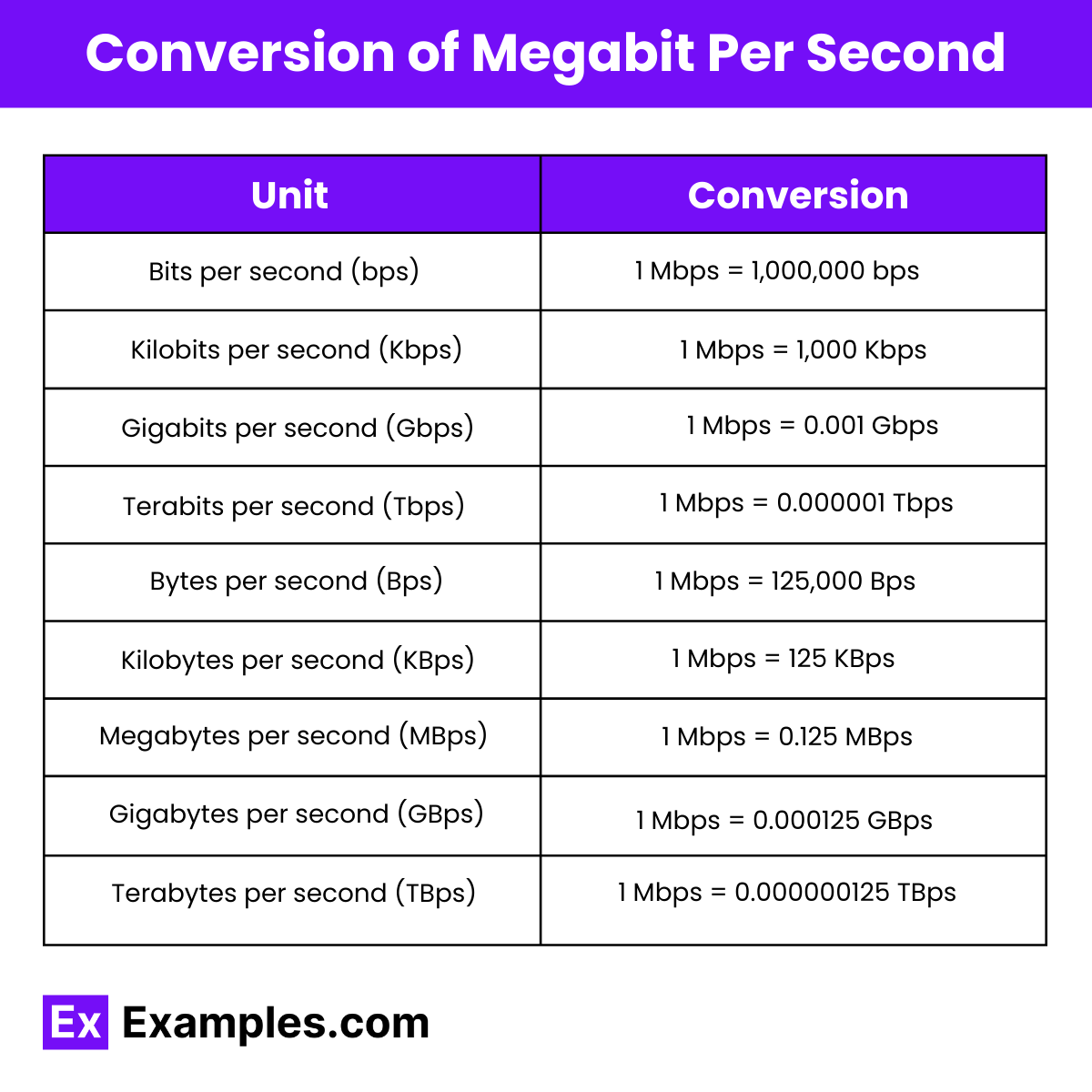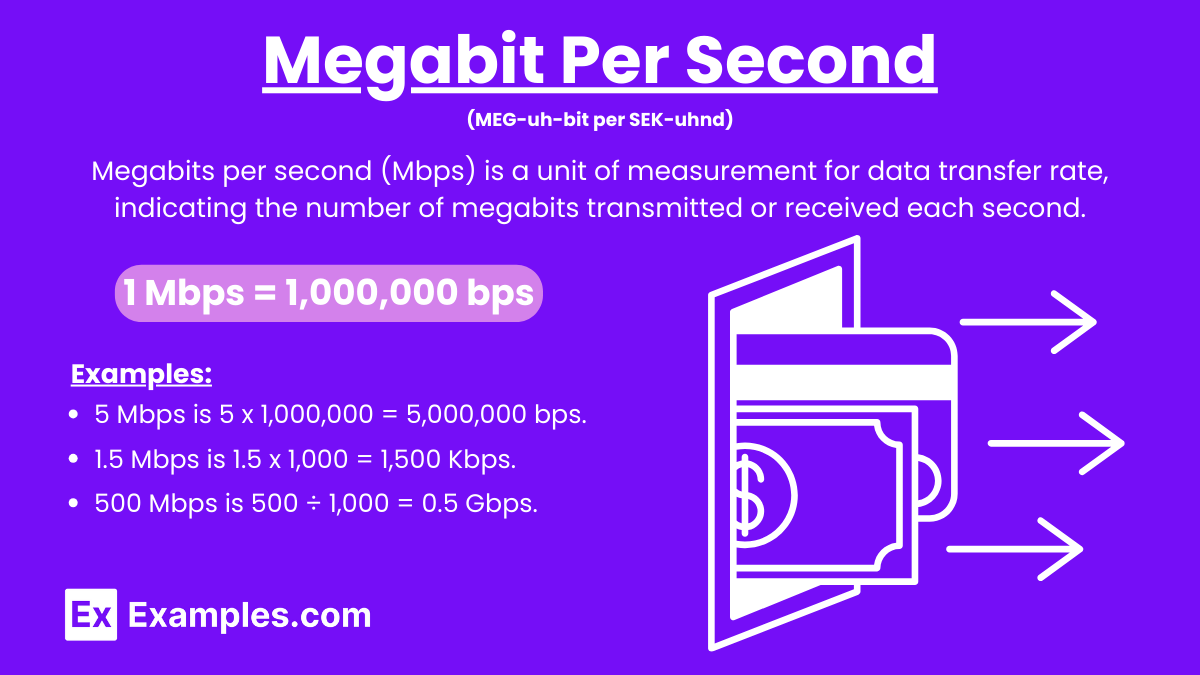15+ Megabit Per Second Examples to Download
Megabits per second (Mbps) is a unit of measurement for data transfer rate, indicating the number of megabits transmitted or received each second. A megabit is equal to one million bits. This unit is commonly used to describe the speed of internet connections, network bandwidth, and data transfer rates in digital communication systems. Higher Mbps values represent faster data transfer rates, which are essential for activities such as streaming high-definition videos, online gaming, and large file downloads. In different contexts, other units of speed are used, such as foot per second, meter per second, and miles per second, to measure the velocity of objects. Each of these units provides a specific way to understand the rate at which something moves over a given second, whether it’s data through a network or physical objects in motion.
What is Megabit Per Second?
Megabits per second (Mbps) measures how quickly data is transferred over a network, with one megabit equaling one million bits. This unit is commonly used to indicate the speed of internet connections and other digital communication systems. A higher Mbps value means data can be transmitted faster, which is crucial for smooth streaming, quick downloads, and efficient online activities. Understanding units of measurement is essential in various fields, including data transfer rates. Different measurement units are used to quantify speed and length, such as meters or feet. A measurement chart can help convert between these units, ensuring accuracy and clarity in communication.
Examples of Megabit Per Second
- Downloading a high-definition movie
- Streaming a 4K video
- Video conferencing on Zoom or Skype
- Online gaming
- Streaming music on Spotify
- Backing up data to the cloud
- Downloading large software updates
- Uploading videos to YouTube
- Watching live sports events online
- Streaming virtual reality content
- Using cloud-based productivity tools like Google Docs
- Downloading high-resolution images
- Transferring large files via FTP
- Streaming live events on social media platforms
- Participating in an online webinar
Megabit Per Second Formula
The formula to calculate the data transfer rate in megabits per second (Mbps) is:
Data Transfer Rate (Mbps) = Time Taken (Seconds)/Total Data Transferred (Megabits)
Steps to Use the Formula
- Determine the Total Data Transferred
- Measure the total amount of data transferred.
- Convert this amount to megabits (Mb) if it is in another unit (e.g., bytes, kilobits).
- Measure the Time Taken
- Measure the total time taken for the data transfer in seconds.
- Apply the Formula
- Divide the total data transferred (in megabits) by the time taken (in seconds) to get the data transfer rate in megabits per second (Mbps).
Conversion of Megabit Per Second

| Unit | Conversion |
|---|---|
| Bits per second (bps) | 1 Mbps = 1,000,000 bps |
| Kilobits per second (Kbps) | 1 Mbps = 1,000 Kbps |
| Gigabits per second (Gbps) | 1 Mbps = 0.001 Gbps |
| Terabits per second (Tbps) | 1 Mbps = 0.000001 Tbps |
| Bytes per second (Bps) | 1 Mbps = 125,000 Bps |
| Kilobytes per second (KBps) | 1 Mbps = 125 KBps |
| Megabytes per second (MBps) | 1 Mbps = 0.125 MBps |
| Gigabytes per second (GBps) | 1 Mbps = 0.000125 GBps |
| Terabytes per second (TBps) | 1 Mbps = 0.000000125 TBps |
Understanding how to convert data transfer rates to other common units is crucial when dealing with different data speeds, whether you’re configuring network settings, comparing internet speeds, or ensuring accurate data rates for projects. Here’s a straightforward guide to converting data transfer rates to and from other common units:
Megabits per second (Mbps) to Bits per second (bps)
Multiply the Mbps value by 1,000,000 to convert to bps.
Example: 5 Mbps is 5 x 1,000,000 = 5,000,000 bps.
Megabits per second (Mbps) to Kilobits per second (Kbps)
Multiply the Mbps value by 1,000 to convert to Kbps.
Example: 1.5 Mbps is 1.5 x 1,000 = 1,500 Kbps.
Megabits per second (Mbps) to Gigabits per second (Gbps)
Divide the Mbps value by 1,000 to convert to Gbps.
Example: 500 Mbps is 500 ÷ 1,000 = 0.5 Gbps.
Megabits per second (Mbps) to Terabits per second (Tbps)
Divide the Mbps value by 1,000,000 to convert to Tbps.
Example: 2,000 Mbps is 2,000 ÷ 1,000,000 = 0.002 Tbps.
Megabits per second (Mbps) to Bytes per second (Bps)
Multiply the Mbps value by 125,000 to convert to Bps.
Example: 4 Mbps is 4 x 125,000 = 500,000 Bps.
Megabits per second (Mbps) to Kilobytes per second (KBps)
Multiply the Mbps value by 125 to convert to KBps.
Example: 8 Mbps is 8 x 125 = 1,000 KBps.
Megabits per second (Mbps) to Megabytes per second (MBps)
Divide the Mbps value by 8 to convert to MBps.
Example: 16 Mbps is 16 ÷ 8 = 2 MBps.
Megabits per second (Mbps) to Gigabytes per second (GBps)
Divide the Mbps value by 8,000 to convert to GBps.
Example: 32,000 Mbps is 32,000 ÷ 8,000 = 4 GBps.
Megabits per second (Mbps) to Terabytes per second (TBps)
Divide the Mbps value by 8,000,000 to convert to TBps.
Example: 8,000,000 Mbps is 8,000,000 ÷ 8,000,000 = 1 TBps.
Importance of Megabit Per Second
Just as KBps is used to measure data transfer rates, other units of measurement like yard, centimeter, and millimeter are used to quantify length in various contexts. Using a measurement chart helps convert between these units, providing clarity and precision in different fields of study and application.
- Internet Connection Speed: Mbps determines the speed and efficiency of internet connections.
- Streaming Quality: Ensures high-quality video streaming without interruptions.
- Online Gaming: Provides a fast and stable connection for better gaming experiences.
- File Downloads and Uploads: Facilitates quick data transfers.
- Video Conferencing: Enhances the quality of virtual meetings.
- Cloud Services: Improves performance and reliability of cloud applications.
- Multiple Devices: Supports the simultaneous use of several devices.
- Economic Growth: Contributes to economic development and productivity.
- Digital Innovation: Drives the development of new technologies.
- Customer Satisfaction: Attracts and retains customers with higher speeds.
Where do you use of Megabit Per Second
- Data Storage and Transfer Measurement: Kibibits per second are used to measure data transfer rates in scenarios where precision is critical. This includes transferring data between storage devices, such as hard drives, SSDs, and NAS systems, especially in computing environments that prefer binary measurement units.
- Network Performance Monitoring: Network administrators use kibibits per second to monitor and analyze network performance. This unit provides a more accurate representation of data transfer rates, especially in binary-based computing systems. Tools and software for network monitoring often display data rates in Kibps.
- Scientific Research and High-Performance Computing (HPC): In scientific research and HPC environments, data transfer rates are measured in kibibits per second to ensure precision and accuracy. This is important for tasks that involve large datasets and require high data throughput, such as simulations, data analysis, and processing.
- Data Center Operations: Data centers use Kibps to measure and manage data transfer rates between servers, storage systems, and network infrastructure. This helps in optimizing data flow, reducing bottlenecks, and ensuring efficient operation of data center resources.
- File Transfers and Backups: When transferring large files or performing backups, data transfer rates might be measured in Kibps to provide a precise understanding of the transfer speed. This is particularly useful in environments that deal with substantial data volumes and require exact measurements.
- Cloud Computing Services: Cloud service providers may use Kibps to measure and advertise data transfer rates for their services. This includes data transfer between cloud storage, virtual machines, and other cloud-based resources, ensuring transparency and accuracy in billing and performance metrics.
How many bits are in a megabit?
A megabit contains 1,000,000 bits.
How does Mbps differ from MBps?
Mbps measures data transfer speed in megabits per second, while MBps measures it in megabytes per second. One byte equals eight bits.
What is considered a good Mbps speed for internet?
A good speed depends on usage, but generally, 25 Mbps is sufficient for most households for streaming and browsing.
Why is internet speed measured in Mbps?
Internet speed is measured in Mbps because it provides a standard unit to quantify and compare data transfer rates.
How does Mbps affect streaming quality?
Higher Mbps provides smoother streaming with less buffering, especially for high-definition or 4K video content.
What influences the Mbps of my internet connection?
Factors include your internet plan, network congestion, distance from the router, and the quality of your hardware.
Is 100 Mbps fast enough for gaming?
Yes, 100 Mbps is usually fast enough for gaming, allowing for low latency and quick downloads.
Can multiple devices affect my Mbps?
Yes, multiple devices sharing the same network can reduce the available Mbps per device, affecting overall speed.
What Mbps is needed for 4K streaming?
For 4K streaming, you typically need at least 25 Mbps per stream to avoid buffering and maintain quality.
How does Mbps relate to download time?
Higher Mbps results in faster download times. For example, at 100 Mbps, a 1 GB file takes about 80 seconds to download.


